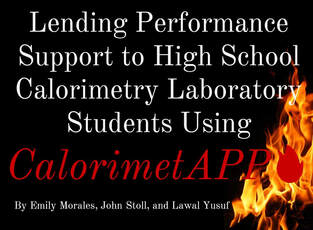Instructional Design Projects
Presently, I teach organic chemistry, chemistry, introductory physics, advanced physics, and fiber arts at the high school level. With an extensive background in science content and research skills, it is with great satisfaction that I have the opportunity to develop instructional materials in the sciences, and test their effectiveness in the classroom on a regular basis. These projects below represent but a sampling of many of the projects I have worked on over the past several years. You may click on each projects respective image to explore!
Blended-learning Organic Chemistry Course
One of my favorite yet most challenging courses in college was Organic Chemistry. While certainly aware at the time it was brutal - as evidenced by the ever-emptying seats in the lecture hall with every passing mid-term - I could not fully appreciate the challenge it poses to undergraduates until writing a research paper justifying it's implementation at the high school level.
Informed by ARCS Model for Motivational Design (2009) and Sweller's Cognitive Load Theory, I developed one chapter of a blended-learning course using the Dick, Carey, and Carey Model (2015) of instructional design. Go ahead, launch the course and enjoy but a glimpse of the beautiful world of organic molecules. |
APA Writing Support Webpage for High School Science Students
Yet another great challenge faced when in college, was that of writing empirical studies in APA format. Students, after completing a laboratory, are instructed to write up such a study, making sure they break down the paper into sections including an Introduction, Methods, Results, and Discussion.
This module was designed for my advanced science students, as a guide to assist them in what is often their first technical writing endeavor. Students not only face the challenges of adhering to APA style with respect to citations, headings and other format issues, but also that of making sure they limit technical dialogue to each respective section. As an example, students should not report "results," in the methods sections of their paper; nor should they discuss theory in the results section. |
CalorimetAPP - Mobile App for General Chemistry Calorimetry Lab
Teaching high school chemistry is one of my favorite things to do, but watching students squirm because they are struggling understanding abstract concepts is one of the worst parts of the job. Thermodynamics and heat transfer pose many challenges to students, as they struggle with significant cognitive load.
When students perform a Calorimetry laboratory, they are beset by two types of overload our team (John Stoll and Lawal Yusuf included) tried to minimize in the development of the CalorimetAPP: intrinsic and extraneous. The App was designed to replace a written laboratory protocol, with design features that were intuitive and familiar. Once students activated the App, they followed step-by-step instructions, starting with the collection of laboratory materials, to carrying out the protocol, entering data in a table, and quiz. |
Indy Sci-Cloud Model of Instructional Design
The Indy Sci-Cloud Model of Instructional Design (ISCM) was developed as a systematic model for engineering design for an online science course. Modeled after the Dick, Carey, and Carey (2015) model of design, ISCM starts with a great deal of front-end analysis (learning goals, learners, home-site feasibility/ learning environment), taking into account the unique needs of independent science learners. From the analysis assessment instruments are developed by which instructional materials along with a strategy for delivery are incorporated.
As with any good instructional design model, the ISCM allows for formative feedback for the purpose of improvement and revisions for subsequent iterations. |
Philosophy and History of Science - Assessment Items
One of the more gratifying projects involved writing assessment items for a subject/ topic of my choosing. I discovered through the Online and Blended Assessment (7100) course that quality assessment items demand an engineered process that takes into account the learning objective(s) undergoing assessment, the cognitive process domain being challenged (Remember, Understand, Apply, Analyze, Evaluate, and Create), along with an identification of the knowledge dimension the assessment item typifies (Factual, Conceptual, Procedural, Metacognitive).
Since I love the history and philosophy of science, and I had no assessment materials to even work from, I challenged myself by building assessment items of many types (Multiple Choice, True/False, Matching) using only the books in my home library. |
Sock Monkey iPals Crochet Pattern
|
In addition to these projects, I have also developed whole programs and accompanying materials for:
- a week-long Pre-Engineering Camp for 7th - 12th graders
- a mini Day Camp in Basic Aerodynamics for 7th - 12th graders
- a week-long Summer Intensive in Ballet Science with an emphasis on Newtonian mechanics and Carol Dweck's Mindful Learning model for 9th - 12th grade advanced ballet students
- a week-long Vacation Bible School emphasizing the religious origins of modern science for 4th - 6th graders
- a week-long Chemistry of Soapmaking Science Camp for 5th - 10th graders
- an online Bridge Math Course to sharpen the math skills of learners entering high school level General Chemistry
- teacher training in Motivational Aspects of Design and Cognitive Load Theory
- a mini Day Camp in Bird Watching, Identification, Natural History and Drawing for 5th to 8th graders
Image Credits:
Image credit of the Milky Way Galaxy: NASA/JPL-Caltech/R. Hurt (SSC/Caltech). Retrieved from: https://astronomynow.com/2015/06/07/charting-the-milky-way-from-the-inside-out/
Image of vintage periodic table of elements retrieved from: https://printmeposter.com/blog/periodic-table-poster-efficient-visual-aid-for-a-chemistry-class-and-a-great-decoration-for-walls/
Image of Michelangelo's God and Adam's hands retrieved from: https://experimentaltheology.blogspot.com/2010/05/michelangelo-and-neuroanatomy.html
Image of Robert Boyle retrieved from: https://www.dkfindout.com/us/science/famous-scientists/robert-boyle/
Image credit of the Milky Way Galaxy: NASA/JPL-Caltech/R. Hurt (SSC/Caltech). Retrieved from: https://astronomynow.com/2015/06/07/charting-the-milky-way-from-the-inside-out/
Image of vintage periodic table of elements retrieved from: https://printmeposter.com/blog/periodic-table-poster-efficient-visual-aid-for-a-chemistry-class-and-a-great-decoration-for-walls/
Image of Michelangelo's God and Adam's hands retrieved from: https://experimentaltheology.blogspot.com/2010/05/michelangelo-and-neuroanatomy.html
Image of Robert Boyle retrieved from: https://www.dkfindout.com/us/science/famous-scientists/robert-boyle/






